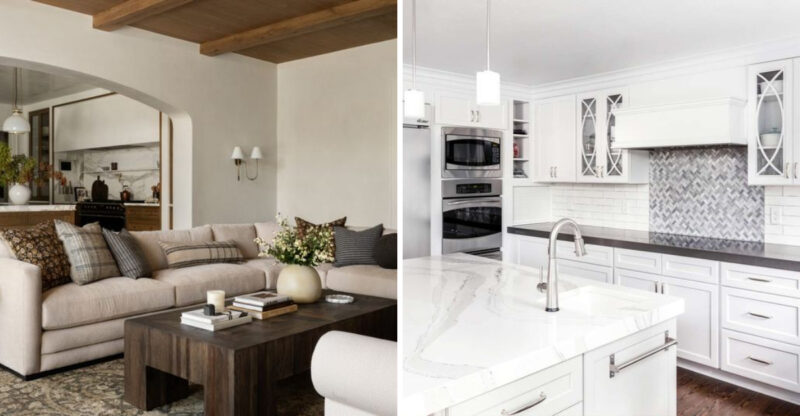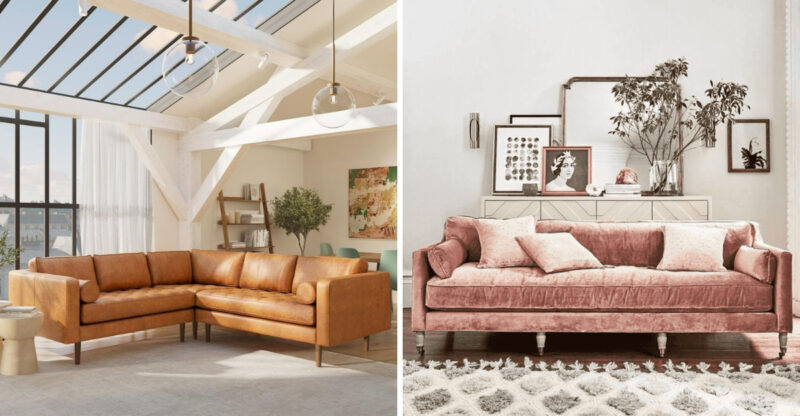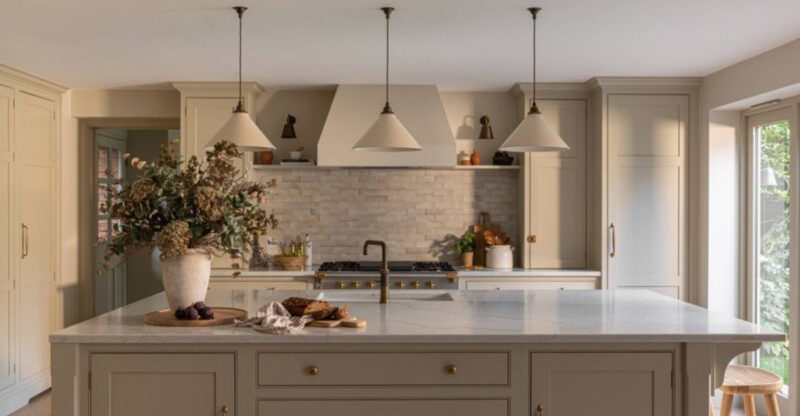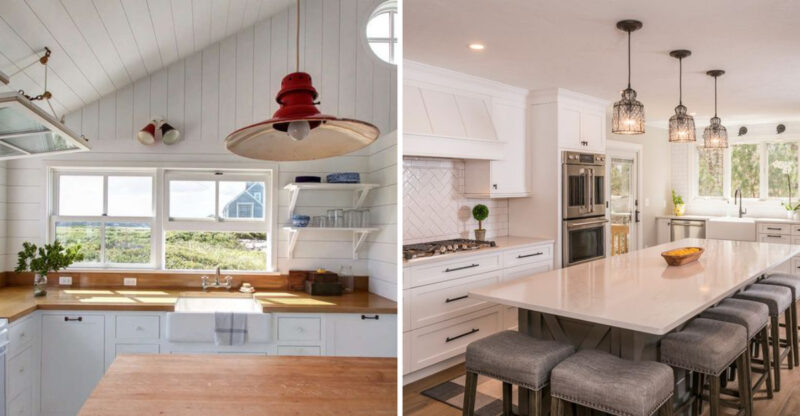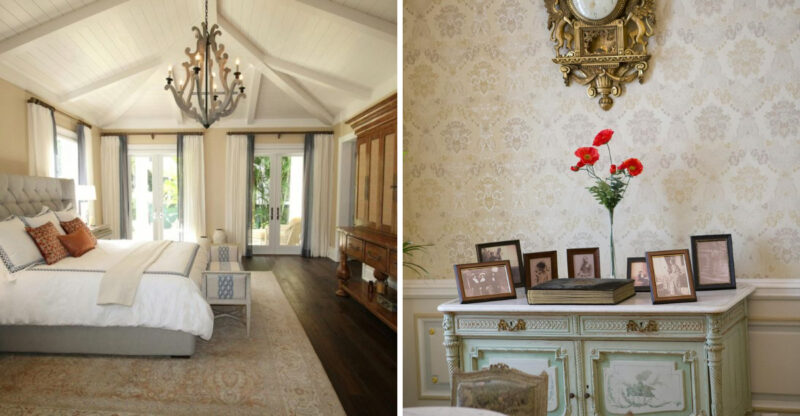28 Depression Glass Patterns You Should Always Keep An Eye Out For At The Thrift Store
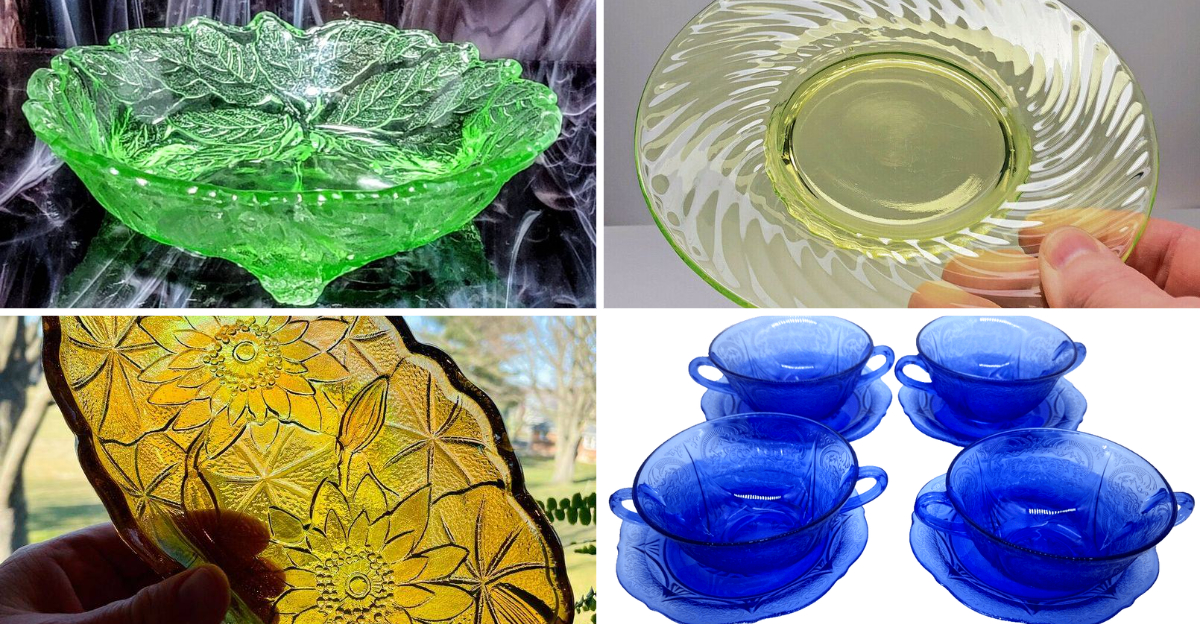
Depression glass, those colorful and affordable dishes produced during the 1920s and 1930s, has become a treasure hunt favorite for thrift store enthusiasts.
These mass-produced pieces were often given away as promotional items during the Great Depression, making them both historically significant and surprisingly affordable finds today.
Whether you’re a seasoned collector or just starting out, knowing which patterns to look for can turn an ordinary thrift store trip into an exciting discovery adventure.
1. Mayfair (Open Rose)
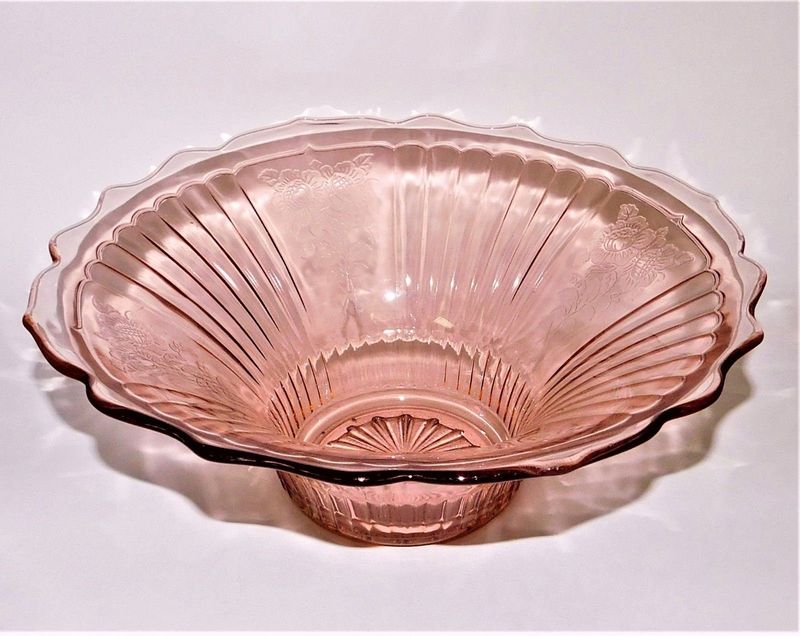
The elegant Mayfair pattern, also known as Open Rose, features delicate rose blooms with open centers that seem to dance across the glass. Made by Hocking Glass Company between 1931 and 1937, this pattern comes primarily in pink, though blue and green pieces exist too.
What makes Mayfair special is the intricate detail in each rose, despite being mass-produced during difficult economic times. Plates typically sell for $15-30, while harder-to-find pieces like covered candy dishes might fetch $75 or more.
If you spot this pattern’s distinctive open roses at a thrift store, don’t hesitate—it’s one of the most sought-after depression glass designs among serious collectors!
2. Cameo (Ballerina)
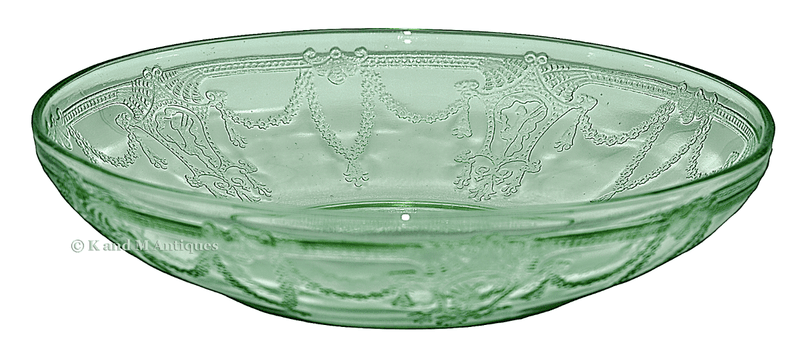
Graceful silhouettes of dancing ballerinas make this pattern instantly recognizable to collectors. Manufactured by Hocking Glass Company between 1930 and 1934, Cameo pieces showcase elegant dancers frozen mid-performance against a textured background.
The soft green color is most common, though you might occasionally find pieces in pink or yellow. When examining potential Cameo finds, look closely at the ballerina figures—they should appear detailed yet delicate.
Did you know this pattern was reissued in the 1970s? To identify original depression-era pieces, check for a slightly uneven texture and subtle manufacturing imperfections that weren’t present in later reproductions. A genuine dinner plate might be worth $20-40, while serving pieces can command $60-100!
3. Princess
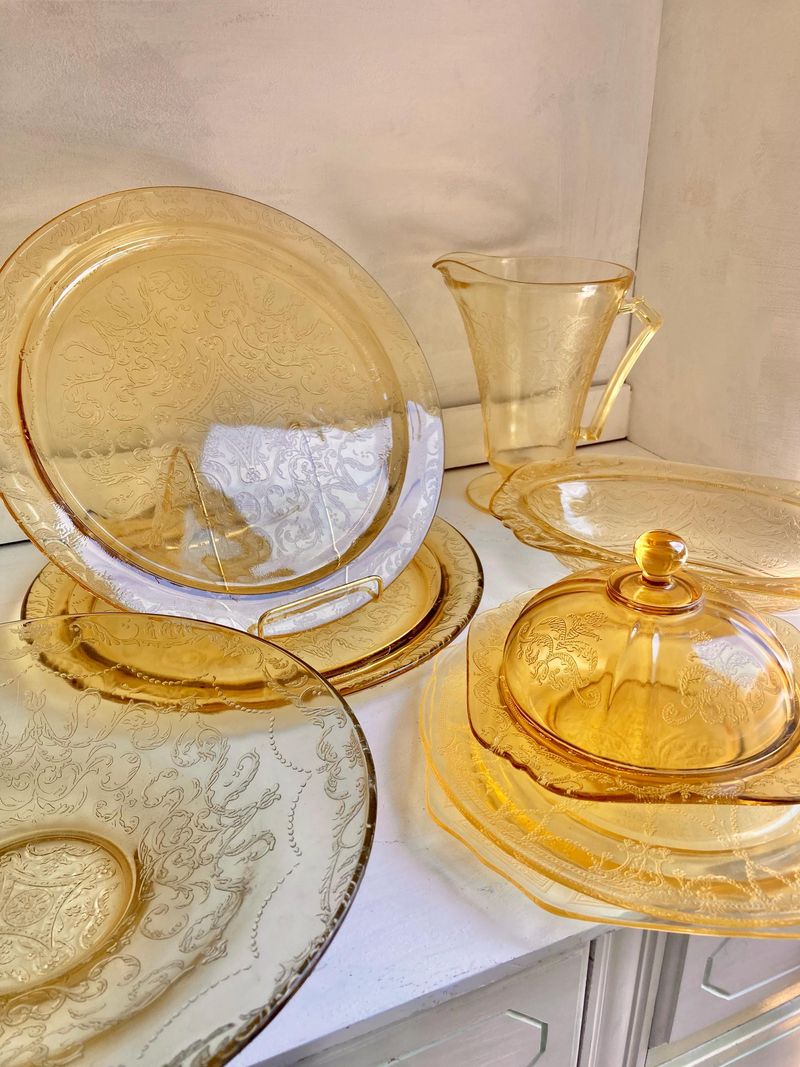
The Princess pattern sparkles with a simple yet sophisticated design of vertical lines and subtle scalloped edges. Hazel Atlas produced this beloved pattern between 1931 and 1934, primarily in a stunning yellow-amber color that collectors call ‘topaz.’
I love how Princess pieces catch and reflect light through their vertical ribbing. This pattern’s popularity means it’s still relatively easy to find, making it perfect for beginning collectors.
When hunting for Princess glass, check butter dishes and covered pieces carefully—their lids are often damaged or missing. Complete sets in good condition command higher prices. A single dinner plate might cost $15-25, while intact covered pieces can sell for $40-70 if you’re lucky enough to spot them!
4. American Sweetheart
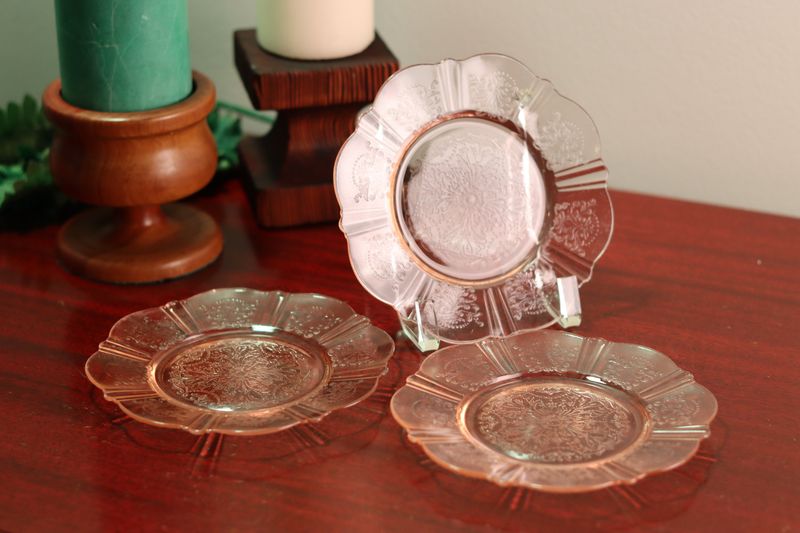
MacBeth-Evans created this romantic pattern between 1930 and 1936, featuring delicate scalloped edges and an intricate floral design that radiates from the center. The pink version remains most popular, though you might discover pieces in blue, green, or crystal clear.
American Sweetheart’s charm lies in its perfect balance of femininity and functionality. Each piece features a lacy, geometric pattern that somehow manages to look both structured and soft simultaneously.
Keep an eye out for the rare cup and saucer sets—they’re particularly valuable since cups were easily broken. A dinner plate might fetch $20-30, but those elusive cups can sell for $40-60 each! This pattern’s romantic name perfectly matches its sweet, nostalgic appeal that continues to captivate collectors today.
5. Royal Lace
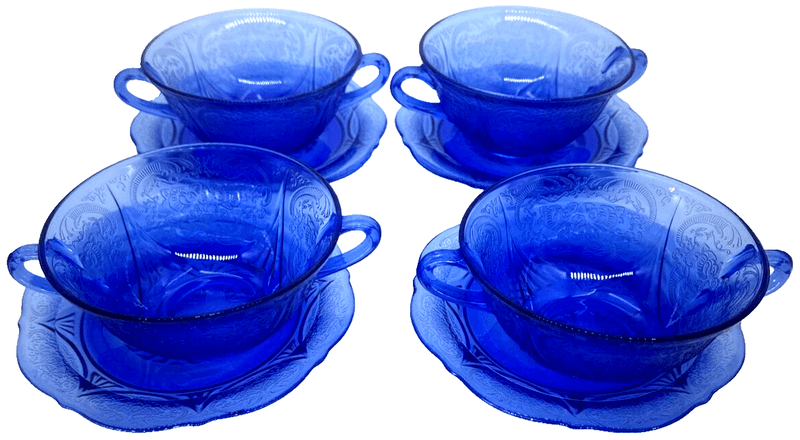
Hazel Atlas produced this majestic pattern between 1934 and 1941, making it one of the later depression glass designs. Royal Lace features an intricate lace-like border surrounding a central starburst, creating a truly regal appearance.
Cobalt blue pieces are rare treasures, while the clear version appears more commonly. The pattern’s complexity makes it especially impressive imagine the technical skill required to mass-produce such detailed glassware during economic hardship!
When examining potential Royal Lace finds, inspect closely for chips around the delicate edges. Even with minor flaws, this pattern remains highly collectible. A dinner plate typically sells for $30-50, while serving pieces can command $75-150. The cobalt blue pieces? They might fetch several hundred dollars if you’re lucky enough to discover one!
6. Cherry Blossom
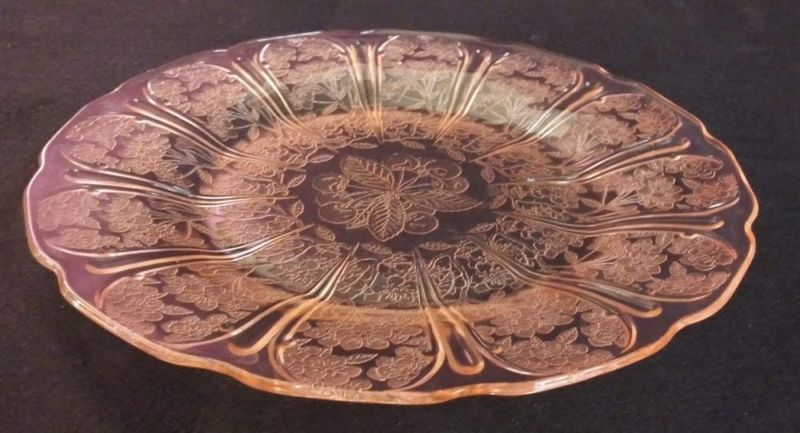
Jeannette Glass Company created this springtime-inspired pattern between 1930 and 1939. The delicate cherry blossoms that adorn each piece capture the ephemeral beauty of these beloved flowers, making this pattern eternally popular.
Pink pieces remain the most sought-after, though green, yellow, and clear versions also exist. Cherry Blossom’s charm lies in its perfect balance of floral elements without becoming overly fussy or feminine.
Serious collectors seek out the harder-to-find serving pieces like cake plates and covered candy dishes. A dinner plate might sell for $20-30, while specialty items can fetch $50-100 or more. Fun fact: this pattern was so popular that Jeannette reissued it in the 1970s, so check for subtle differences in color and mold marks to identify original depression-era pieces!
7. Patrician (Spoke)
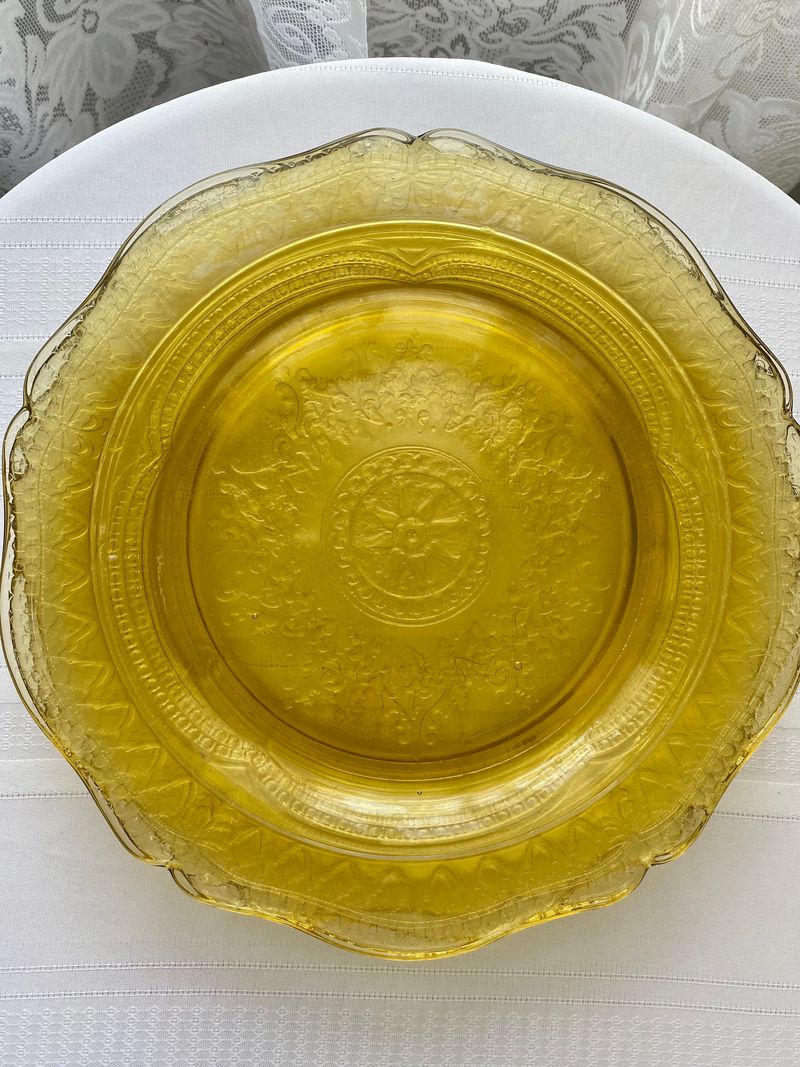
Federal Glass Company produced this geometric wonder between 1933 and 1937. Also known as Spoke, the Patrician pattern features clean lines radiating from the center like bicycle spokes, creating a surprisingly modern look for its era.
Amber pieces are most common, though you might discover this pattern in green, pink, or crystal clear. The pattern’s simplicity makes it versatile enough to mix with contemporary tableware.
When hunting for Patrician glass, examine pieces in good lighting—the pattern can be subtle in certain angles. A dinner plate typically sells for $15-25, while serving pieces might fetch $30-60. This pattern appeals to both traditional collectors and those with more modern aesthetic sensibilities, making it a versatile addition to any depression glass collection!
8. Florentine No. 2
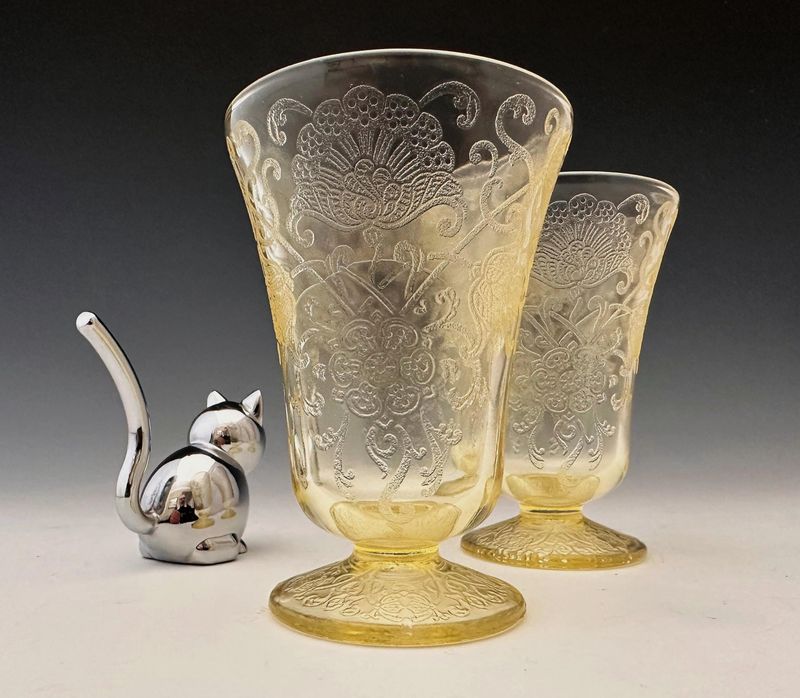
Hazel Atlas manufactured this cheerful pattern between 1932 and 1935. The bright yellow color (officially called “Poppy Yellow”) makes Florentine No. 2 instantly recognizable, though it occasionally appears in green, pink, or crystal clear.
Small, precisely etched flowers dance across each piece, creating a lively yet elegant effect. This pattern’s popularity during the Depression stemmed from its ability to brighten tables during difficult times.
Look for the distinctive yellow hue when thrifting—it practically glows under store lighting! A dinner plate typically sells for $20-35, while serving pieces can command $50-80. Why the “No. 2” in the name? It replaced an earlier, less successful Florentine pattern, proving that sometimes the sequel outshines the original!
9. Sharon (Cabbage Rose)
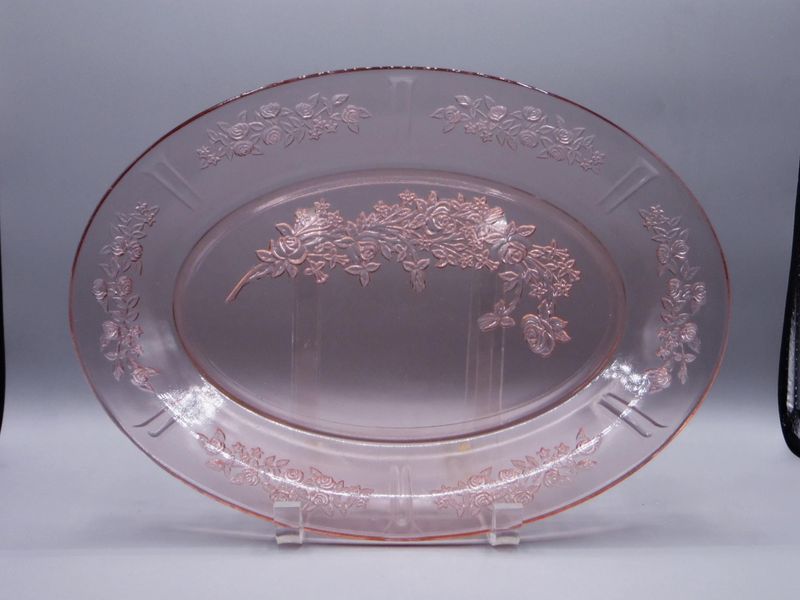
Federal Glass Company created this romantic pattern between 1935 and 1939. Sharon features lush cabbage roses with detailed leaves that seem to bloom across each piece, earning it the nickname “Cabbage Rose” among collectors.
The pink version remains most coveted, though amber pieces appear more frequently at thrift stores. When examining potential Sharon finds, look closely at the rose details they should have clearly defined petals and leaves.
This pattern’s popularity means reproductions exist, so check for the slightly uneven texture and subtle manufacturing variations found in original pieces. A dinner plate typically sells for $20-40, while serving pieces might fetch $50-90. The pattern’s romantic appeal makes it perfect for displaying in vintage-inspired kitchens or dining rooms!
10. Block Optic
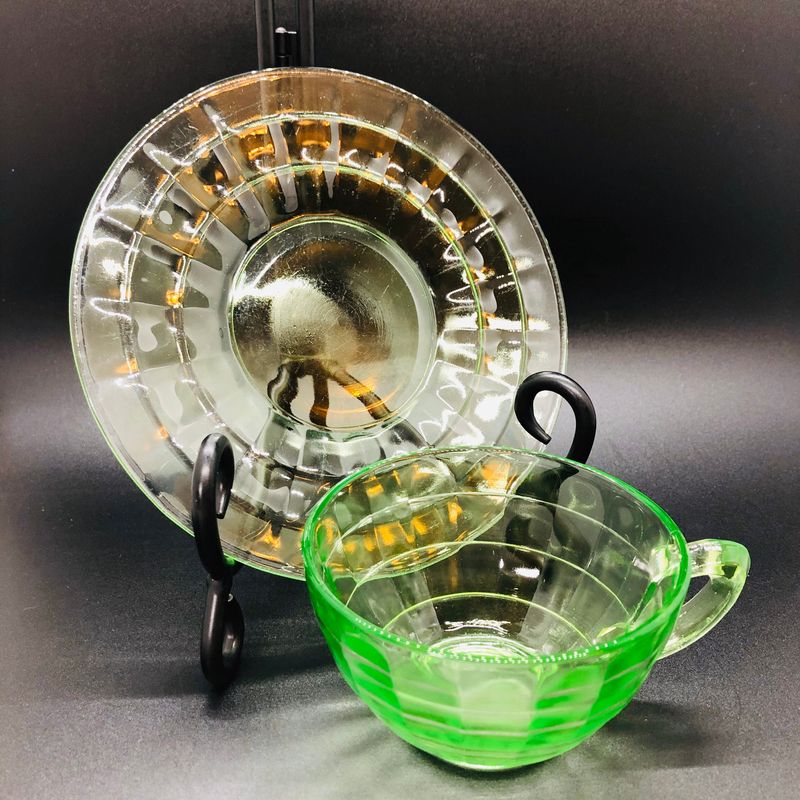
Hocking Glass Company produced this geometric marvel between 1929 and 1933. Block Optic features raised squares arranged in concentric circles, creating a fascinating visual and tactile experience.
Green pieces appear most commonly, though you might discover this pattern in pink, yellow, or crystal clear. The pattern’s architectural quality gives it a distinctly Art Deco feel that remains stylish nearly a century later.
I love how Block Optic pieces catch light differently than other patterns, creating interesting shadows and highlights. A dinner plate typically sells for $15-25, while serving pieces might fetch $30-60. This pattern’s geometric simplicity makes it particularly appealing to collectors who prefer clean lines over floral designs—a perfect example of depression glass diversity!
11. Madrid
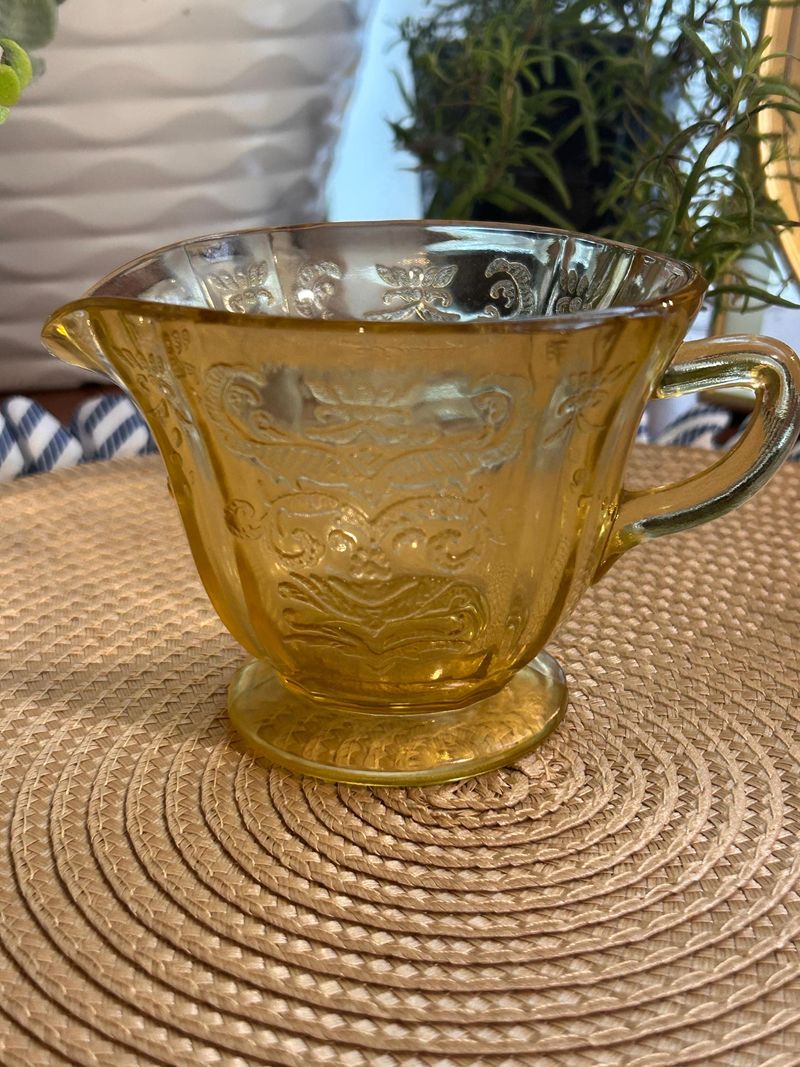
Federal Glass Company created this Spanish-inspired pattern between 1932 and 1939. Madrid features an intricate geometric design that resembles ornate ironwork, giving it a distinctly Mediterranean flair.
Amber pieces are most common, though blue Madrid is particularly prized by collectors. The pattern’s complexity is impressive considering it was mass-produced during economic hardship.
When examining Madrid pieces, check the edges carefully—the intricate pattern makes chips and cracks harder to spot at first glance. A dinner plate typically sells for $20-35, while serving pieces might fetch $40-75. Madrid’s warm amber color pairs beautifully with contemporary earth-toned decor, making it both historically interesting and practically usable in today’s homes!
12. Dogwood (Apple Blossom)
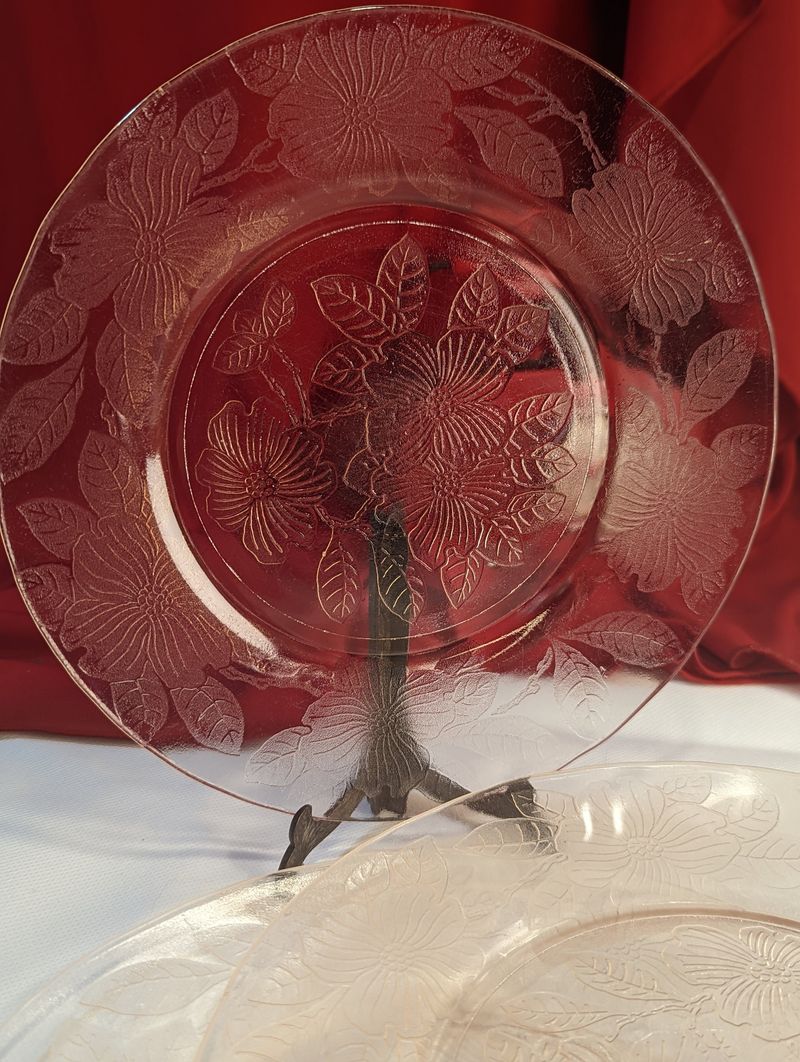
MacBeth-Evans introduced this nature-inspired pattern in 1930, producing it until 1934. The delicate dogwood flowers (sometimes called apple blossoms) appear to float across each piece, creating a dreamy, springtime feel year-round.
Pink pieces remain most sought-after, though green and crystal clear versions also exist. The pattern’s subtle elegance makes it a perennial favorite among collectors and decorators alike.
When hunting for Dogwood glass, examine pieces in good lighting to appreciate the fine details in each blossom. A dinner plate typically sells for $20-35, while harder-to-find serving pieces might fetch $50-90. This pattern pairs beautifully with fresh flowers, making it perfect for display in a sunny window where light can dance through the translucent glass!
13. Miss America
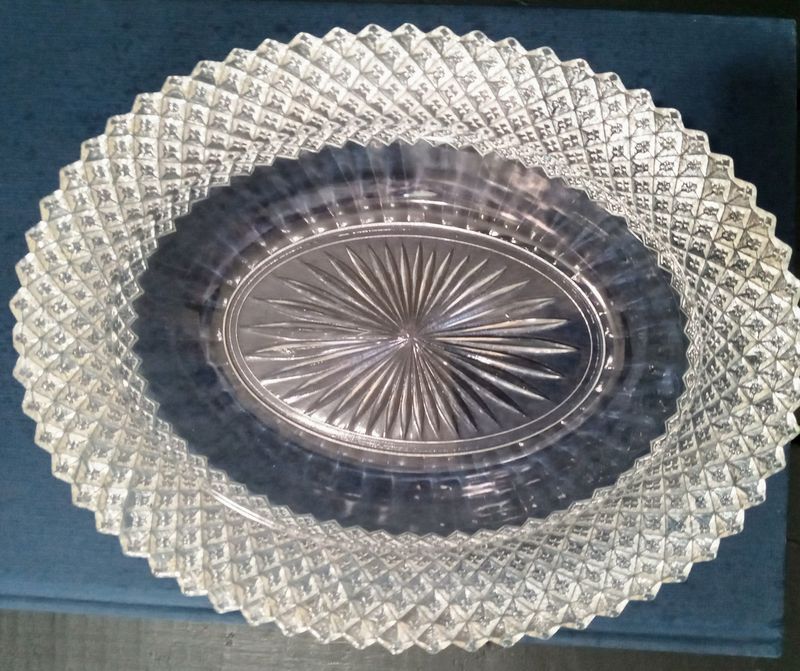
Hocking Glass Company produced this patriotic pattern between 1935 and 1937. Miss America features a bold geometric design with alternating bands of raised dots and lines that create a surprisingly modern aesthetic.
Crystal clear pieces were most common originally, though the pattern also appears in pink and occasionally blue. The crystal version has a diamond-like brilliance when clean and properly displayed.
Miss America’s relatively short production period makes it somewhat harder to find than other patterns. A dinner plate typically sells for $20-40, while serving pieces might fetch $50-100. Despite its name, this pattern has no connection to the famous pageant it simply embodied the American spirit of resilience during challenging economic times!
14. Holiday (Buttons and Bows)
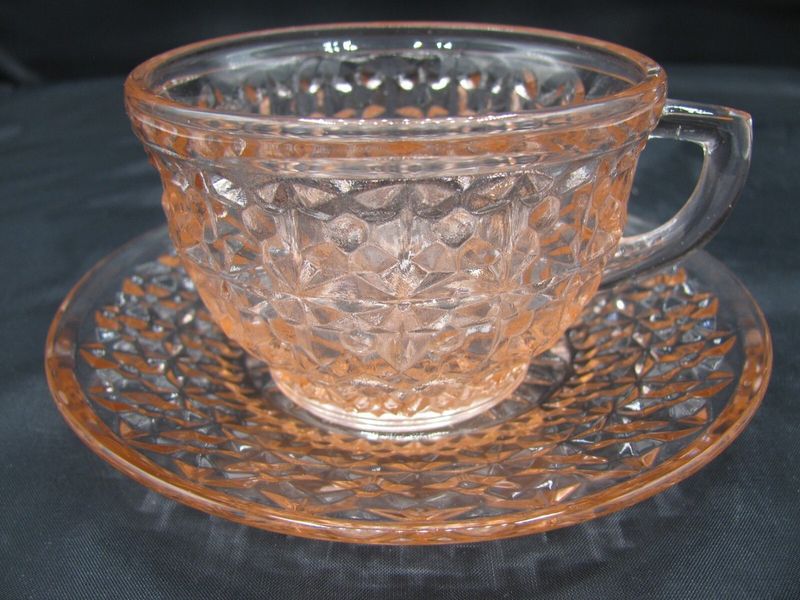
Federal Glass Company created this festive pattern between 1934 and 1938. Also known as Buttons and Bows, Holiday features charming button-like circles connected by ribbon-like arcs, creating a celebratory feel perfect for special occasions.
Green pieces appear most frequently, though pink and crystal clear versions exist too. The pattern’s playful design somehow manages to look both vintage and timeless simultaneously.
Holiday glass tends to have good clarity and color saturation, making it particularly attractive when displayed where light can shine through it. A dinner plate typically sells for $20-35, while serving pieces might fetch $45-80. This pattern’s cheerful design makes it perfect for displaying during winter holidays, though it’s charming enough to enjoy year-round!
15. Sandwich
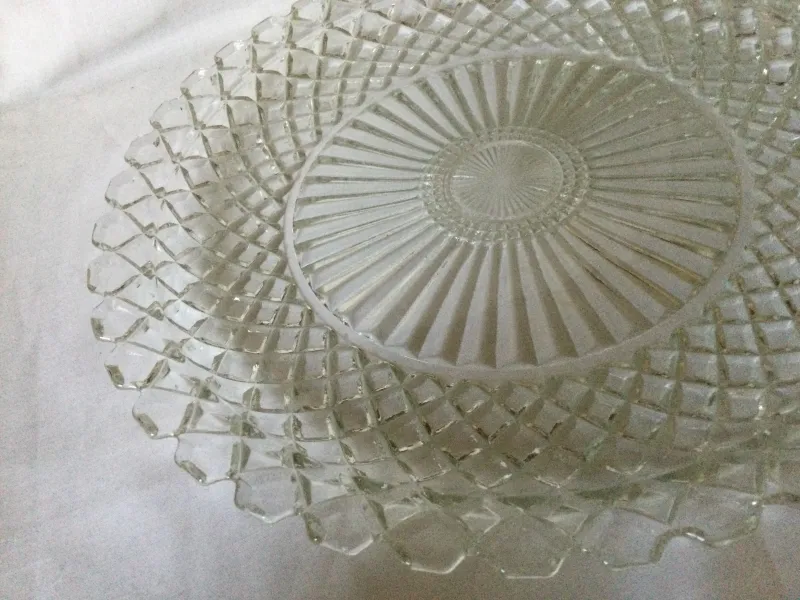
Hocking Glass Company produced this versatile pattern between 1929 and 1933. Sandwich features a distinctive waffle-like texture covering the entire surface, creating interesting light reflections and a satisfying tactile experience.
Crystal clear pieces were original, though the pattern also appears in green, pink, and occasionally blue. The texture provides both visual interest and practical grip—a thoughtful design feature during challenging economic times.
When examining Sandwich glass, hold pieces up to the light to check for tiny bubbles or inclusions that authenticate vintage pieces. A dinner plate typically sells for $15-30, while serving pieces might fetch $35-70. This pattern’s neutral design makes it particularly versatile for mixing with other depression glass patterns or contemporary tableware!
16. Old Colony (Lace Edge)
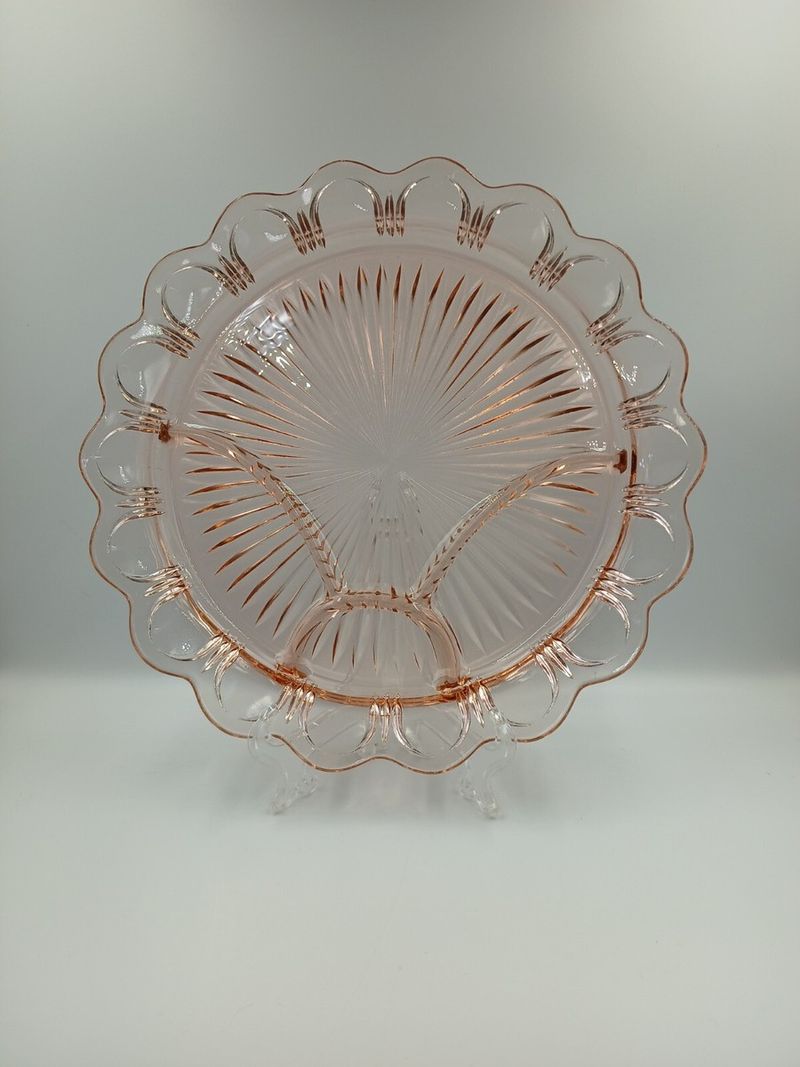
Hocking Glass Company created this elegant pattern between 1935 and 1938. Also called Lace Edge, Old Colony features a delicate lace-like border surrounding a smooth center, creating a refined yet accessible aesthetic.
Pink pieces remain most coveted, though crystal clear versions appear more frequently at thrift stores. The pattern’s name evokes America’s colonial heritage, appealing to patriotic sentiments during difficult times.
When hunting for Old Colony glass, examine the lace border carefully—it should have crisp, well-defined details. A dinner plate typically sells for $20-35, while serving pieces might fetch $45-85. This pattern’s delicate appearance belies its practical durability, making it both beautiful and functional for everyday use or special occasions!
17. Tea Room
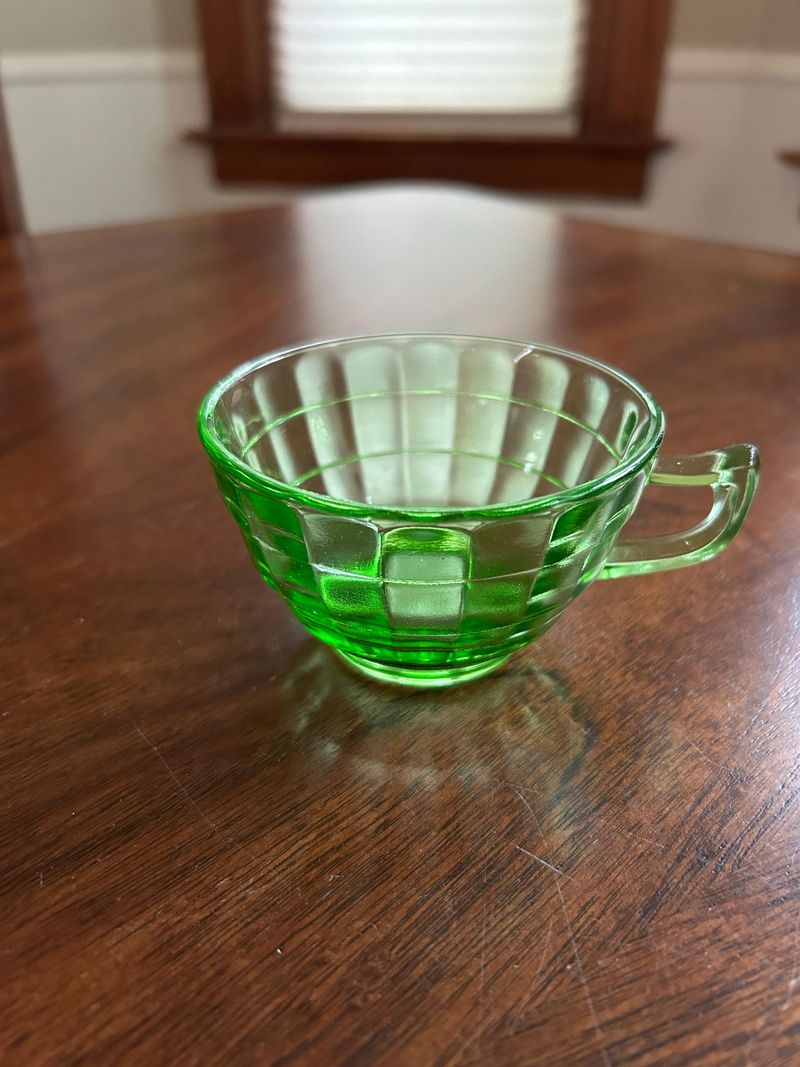
Federal Glass Company produced this sophisticated pattern between 1926 and 1933. Tea Room features vertical panels alternating between smooth and ribbed textures, creating an elegant, architectural effect.
Green pieces appear most commonly, though pink and crystal clear versions exist too. The pattern’s name reflects its intended use in tea rooms and restaurants—places where simple pleasures remained accessible during difficult times.
Tea Room’s early production dates make it among the oldest depression glass patterns, adding historical significance to its aesthetic appeal. A dinner plate typically sells for $20-40, while serving pieces might fetch $50-90. This pattern’s clean lines and subtle texture make it particularly appealing to collectors who prefer understated elegance over more elaborate designs!
18. Waterford (Waffle)
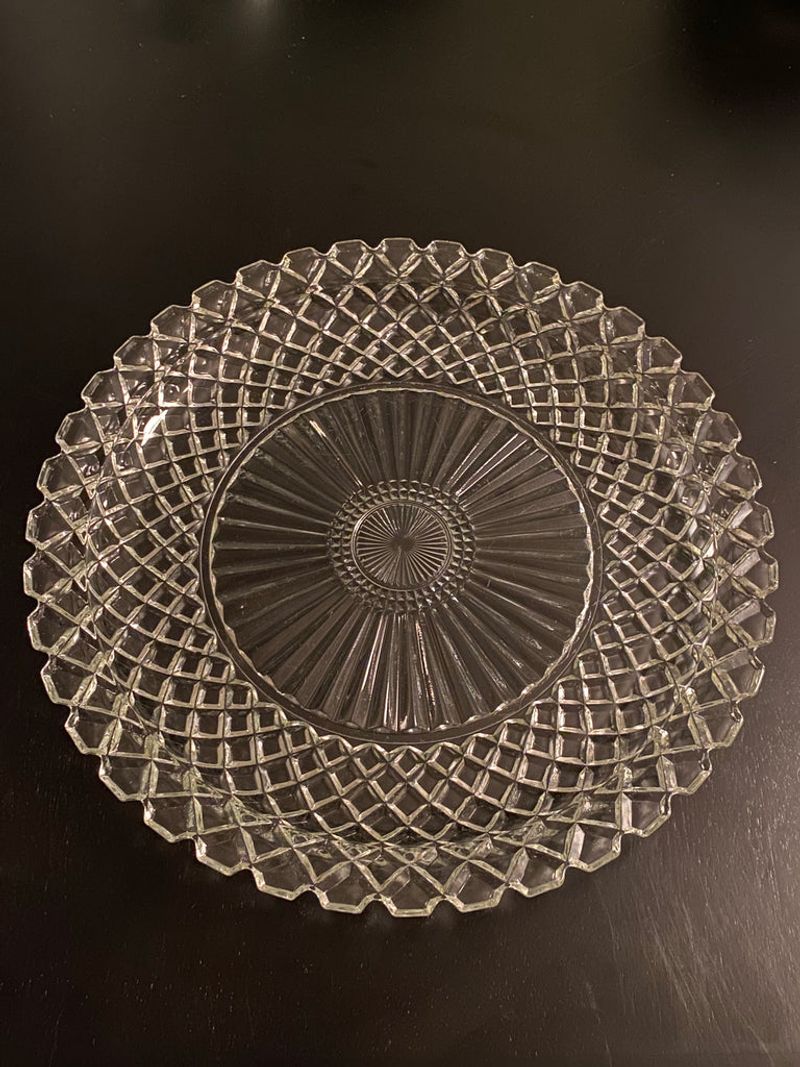
Hocking Glass Company created this textured pattern between 1938 and 1944. Not to be confused with the famous Irish crystal, Waterford depression glass (also called Waffle) features a distinctive waffle-like texture covering the entire surface.
Crystal clear pieces were most common originally, though the pattern also appears in lovely shades of pink and occasionally blue. The texture creates fascinating light reflections while providing practical grip.
Waterford’s later production dates mean it sometimes incorporated more modern manufacturing techniques, resulting in fewer flaws than earlier depression glass. A dinner plate typically sells for $15-30, while serving pieces might fetch $35-75. This pattern’s simple elegance makes it versatile enough to complement both vintage and contemporary table settings!
19. Sierra (Pinwheel)
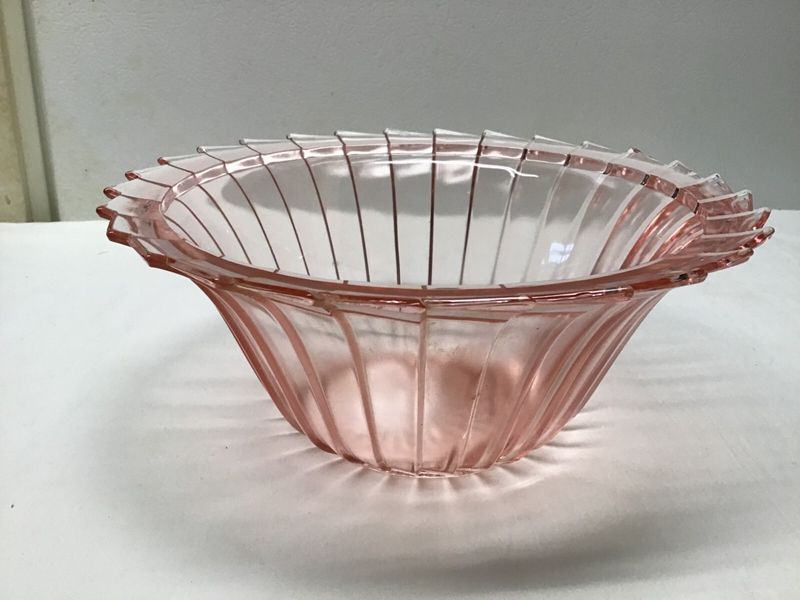
Jeannette Glass Company produced this playful pattern between 1931 and 1933. Also known as Pinwheel, Sierra features a dynamic design of spinning pinwheel shapes that create movement across each piece.
Green pieces appear most commonly, though pink versions are particularly prized by collectors. The pattern’s energetic design somehow manages to feel both vintage and surprisingly modern.
Sierra’s relatively short production period makes authentic pieces somewhat harder to find than other patterns. A dinner plate typically sells for $25-45, while serving pieces might fetch $50-90. This pattern’s whimsical design makes it particularly appealing to collectors who appreciate depression glass with personality and visual energy rather than formal elegance!
20. Adam
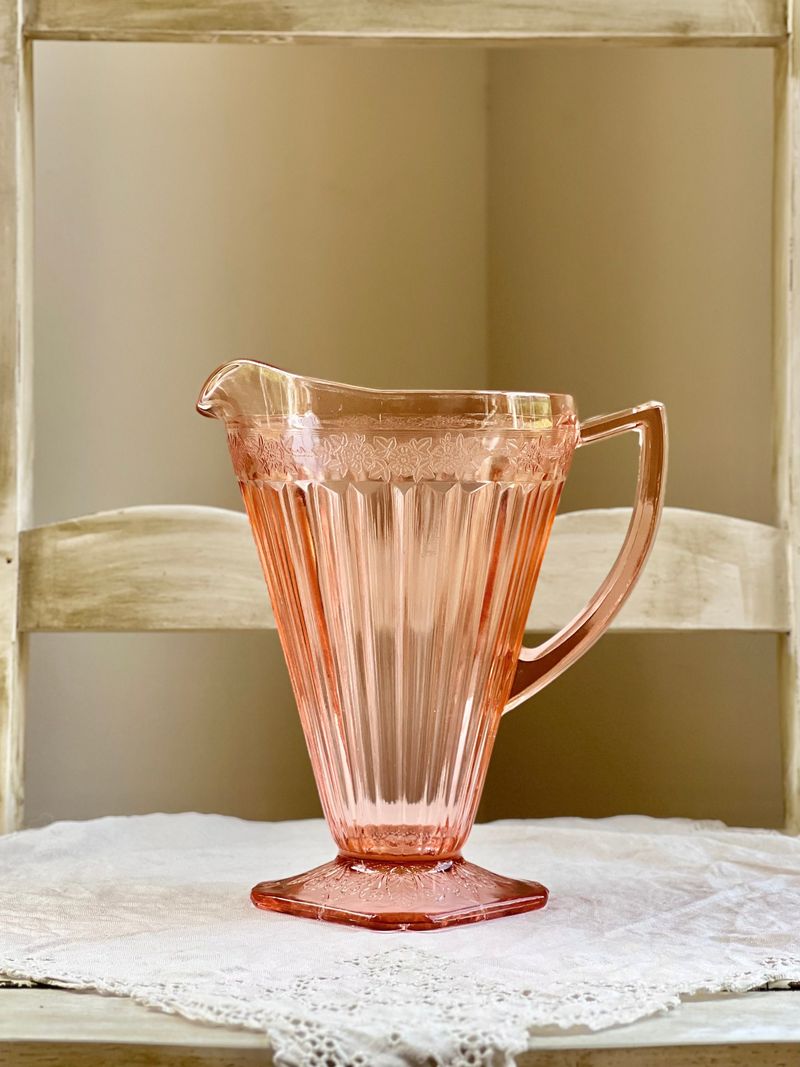
Jeannette Glass Company created this classical pattern between 1932 and 1934. Adam features elegant ribbing around the edges with a smooth center, creating a refined yet accessible aesthetic named after the famous Adam architectural style.
Pink pieces remain most sought-after, though green and crystal clear versions also exist. The pattern’s neoclassical inspiration gave Depression-era tables a touch of historical elegance during difficult times.
When examining Adam glass, check the ribbing for uniformity and clarity—quality pieces have crisp, well-defined details. A dinner plate typically sells for $20-35, while serving pieces might fetch $45-80. This pattern’s timeless design continues to appeal to collectors who appreciate classical influences in their depression glass collection!
21. Sunflower
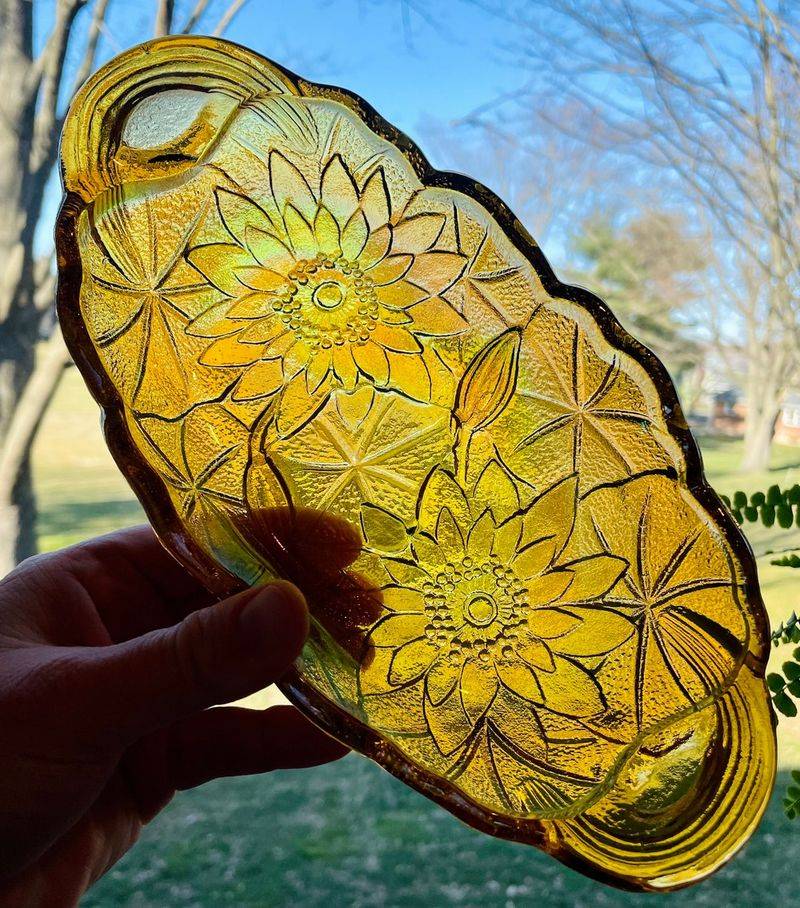
Indiana Glass Company produced this cheerful pattern between 1931 and 1935. Sunflower features detailed blooms with raised petals radiating from a central button, creating a bright, optimistic feel perfect for Depression-era tables.
Amber pieces appear most frequently, creating a warm, honey-colored glow when light shines through them. The pattern’s botanical theme brought nature’s beauty indoors during challenging economic times.
When hunting for Sunflower glass, examine each piece in good lighting to appreciate the fine details in each bloom. A dinner plate typically sells for $25-45, while serving pieces might fetch $50-95. This pattern’s sunny disposition makes it particularly appealing to collectors who appreciate depression glass with personality and natural inspiration!
22. Swirl
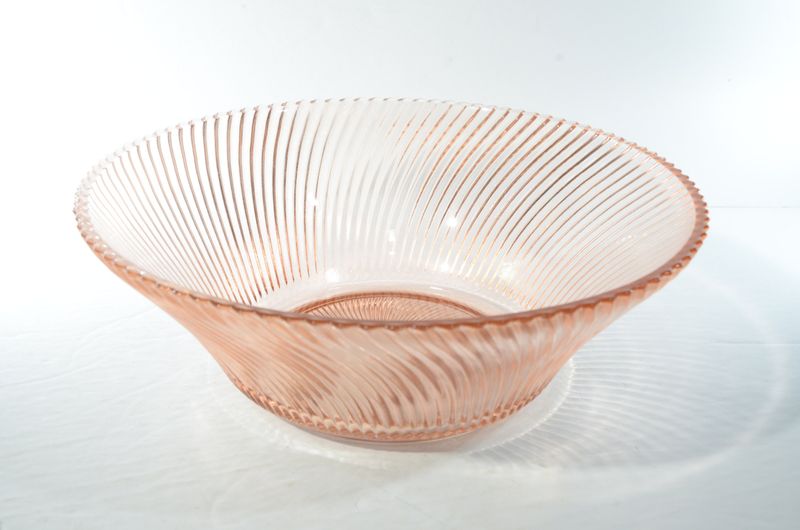
Federal Glass Company created this dynamic pattern between 1937 and 1938. Swirl features graceful spiral lines that seem to dance across each piece, creating a sense of movement and energy.
Pink pieces remain most coveted, though cobalt blue Swirl is particularly rare and valuable. The pattern’s short production period makes authentic pieces somewhat harder to find than other depression glass designs.
When examining potential Swirl finds, check that the spiral pattern remains crisp and well-defined throughout. A dinner plate typically sells for $25-45, while serving pieces might fetch $50-100. This pattern’s energetic design makes it particularly appealing to collectors who appreciate depression glass with visual movement rather than static patterns!
23. Avocado

Indiana Glass Company produced this distinctive pattern between 1923 and 1933. Despite its name, Avocado doesn’t refer to the color but rather to the unique textured design resembling avocado skin covering each piece.
Green pieces appear most commonly, though crystal clear versions exist too. The all-over texture creates interesting light reflections while providing practical grip a thoughtful design feature during challenging economic times.
Avocado’s early production dates make it among the oldest depression glass patterns, adding historical significance to its unique appeal. A dinner plate typically sells for $20-40, while serving pieces might fetch $45-85. This pattern’s unusual texture makes it instantly recognizable even to novice collectors—a conversation starter in any depression glass collection!
24. Colonial Fluted
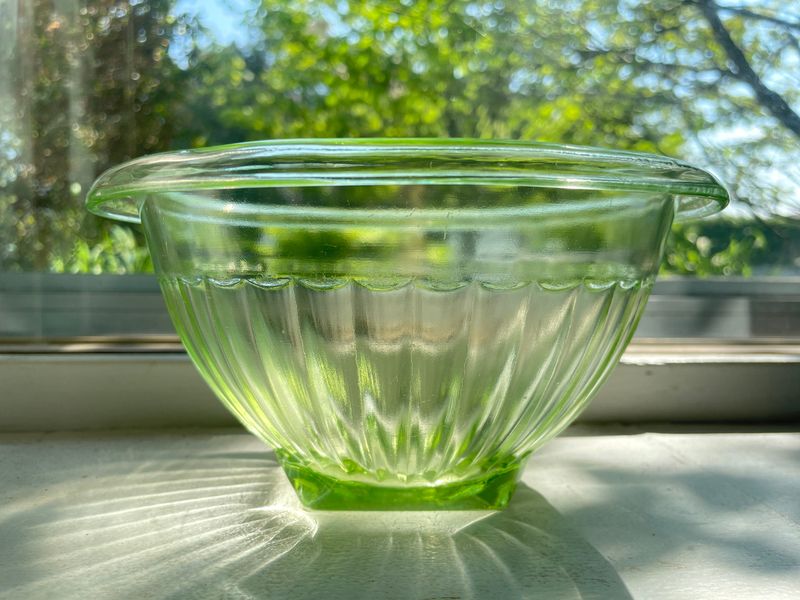
Hazel Atlas manufactured this patriotic pattern between 1934 and 1936. Colonial Fluted features elegant vertical ribbing around the edges with a smooth center, creating a refined yet accessible aesthetic inspired by early American design.
Green pieces appear most frequently, though pink versions are particularly prized by collectors. The pattern’s name evoked America’s colonial heritage, appealing to patriotic sentiments during difficult times.
When examining Colonial Fluted glass, check the ribbing for uniformity and clarity—quality pieces have crisp, well-defined flutes. A dinner plate typically sells for $15-30, while serving pieces might fetch $35-70. This pattern’s timeless design continues to appeal to collectors who appreciate historical influences in their depression glass collection!
25. Spiral Optic
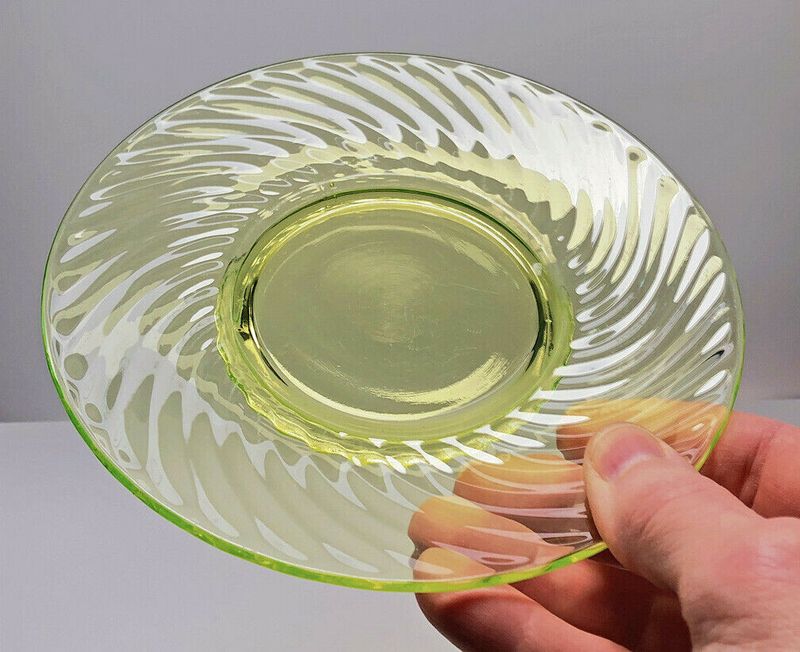
Imperial Glass Company created this dynamic pattern between 1937 and 1939. Spiral Optic features swirling raised lines that create a hypnotic, almost optical illusion effect across each piece.
Crystal clear pieces were most common originally, allowing the pattern’s visual movement to take center stage. The design’s modernist influence shows how depression glass occasionally embraced forward-thinking aesthetics despite being produced during economically conservative times.
When hunting for Spiral Optic glass, examine pieces in good lighting to fully appreciate the three-dimensional quality of the spiral design. A dinner plate typically sells for $20-40, while serving pieces might fetch $45-85. This pattern’s kinetic energy makes it particularly appealing to collectors who appreciate depression glass with visual drama and movement!
26. Georgian (Lovebirds)
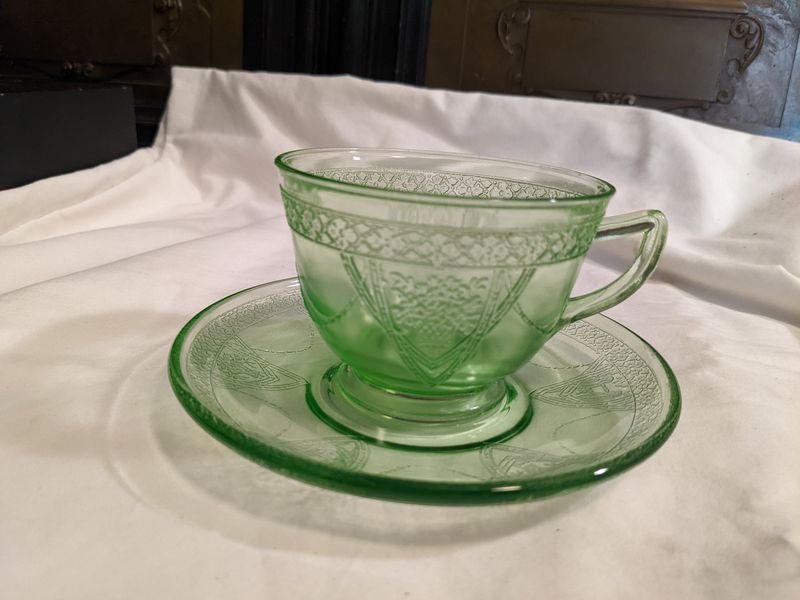
Federal Glass Company produced this romantic pattern between 1931 and 1936. Also known as Lovebirds, Georgian features delicate birds perched among floral elements, creating a sweet, sentimental design perfect for wedding gifts during difficult times.
Crystal clear pieces were most common originally, allowing the etched pattern to shine without color distraction. The design’s romantic theme offered emotional comfort during economically challenging years.
When examining Georgian glass, look closely at the bird details—they should appear delicate yet clearly defined. A dinner plate typically sells for $25-45, while serving pieces might fetch $50-90. This pattern’s romantic symbolism makes it particularly appealing to collectors who appreciate depression glass with narrative qualities and emotional resonance!
27. Spiral Rib
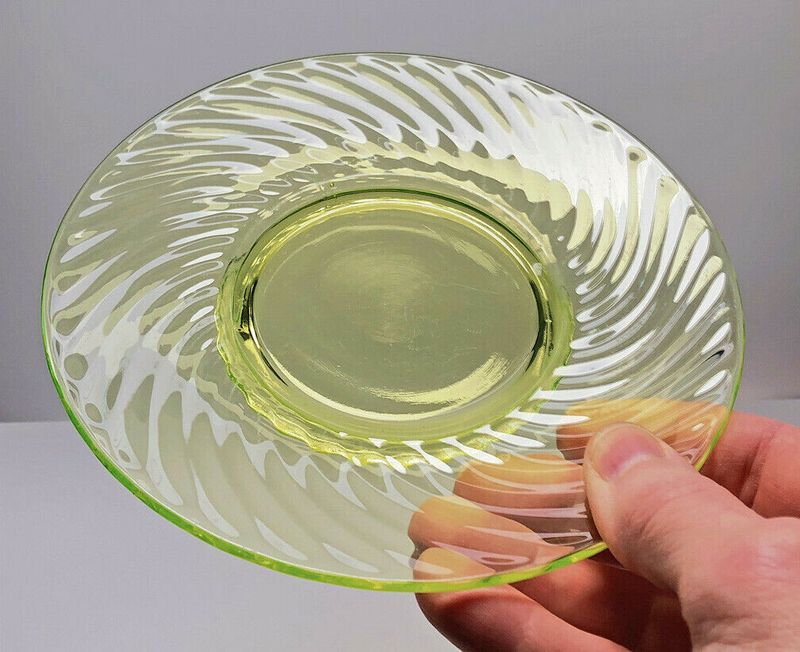
Imperial Glass Company created this architectural pattern between 1930 and 1933. Spiral Rib features diagonal ribbing that creates fascinating light reflections and a satisfying tactile experience.
Green pieces appear most commonly, though crystal clear versions exist too. The pattern’s dynamic design somehow manages to feel both vintage and surprisingly modern.
Spiral Rib’s relatively short production period makes authentic pieces somewhat harder to find than other patterns. A dinner plate typically sells for $20-40, while serving pieces might fetch $45-85. This pattern’s bold texture makes it particularly appealing to collectors who appreciate depression glass with strong visual impact rather than delicate details!
28. Queen Mary
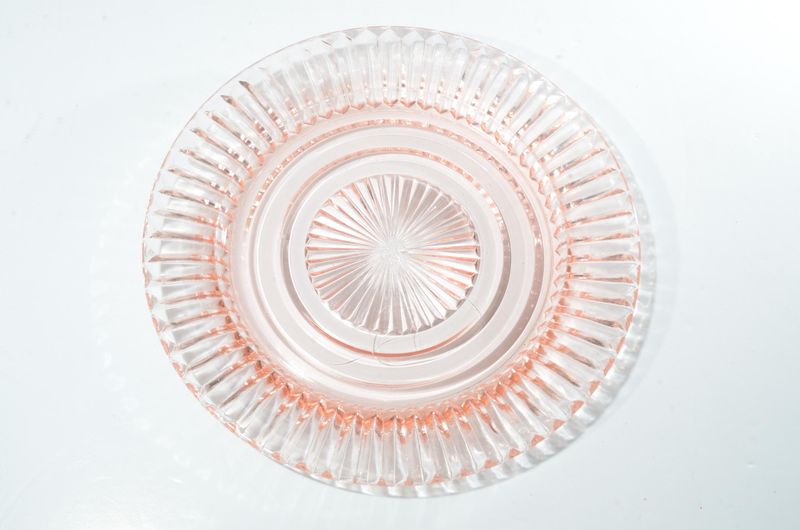
Hocking Glass Company produced this regal pattern between 1936 and 1941. Named after the famous ocean liner (and indirectly, the British queen), Queen Mary features an elegant design of vertical panels alternating between smooth and textured surfaces.
Pink pieces remain most sought-after, though green and crystal clear versions also exist. The pattern’s name evoked luxury and elegance during challenging economic times.
When examining Queen Mary glass, check the panels for crisp definition and uniform spacing. A dinner plate typically sells for $20-40, while serving pieces might fetch $45-90. This pattern’s refined design makes it particularly appealing to collectors who appreciate depression glass with architectural qualities and elegant restraint rather than busy patterns!

